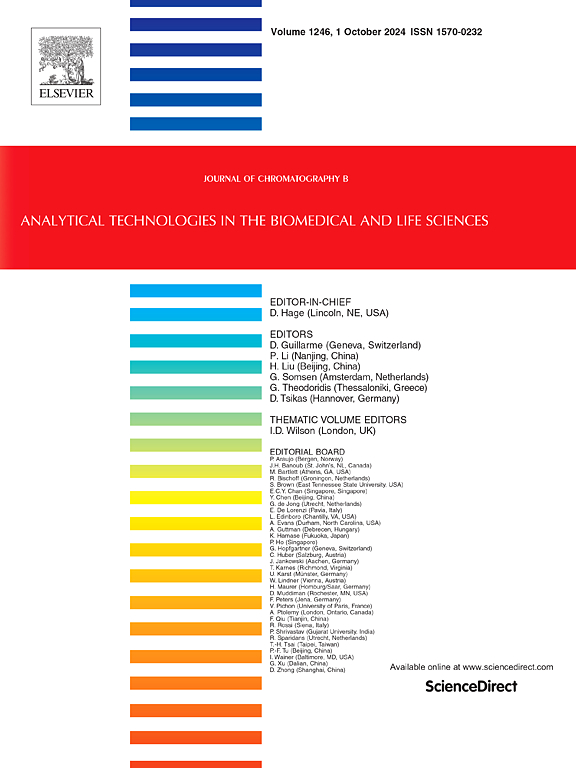解码COVID-19症状阶段的血清n -糖蛋白特征
IF 2.8
3区 医学
Q2 BIOCHEMICAL RESEARCH METHODS
引用次数: 0
摘要
SARS-CoV-2感染引起广泛的临床表现,从无症状病例到致命的结果。尽管在了解SARS-CoV-2方面取得了重大进展,但确定可靠的生物标志物用于早期风险评估和疾病严重程度预测仍然是一个未满足的临床需求。在这项研究中,我们对一组包括轻度至重度症状的COVID-19患者和健康对照者的血清n -糖谱进行了表征。酶解糖基化后,用HILIC-FLD-QTOF-MS分析血清样品。在病例对照比较中,COVID-19患者表现出低寡甘露糖和杂交型聚糖的显著减少,同时四天线和四半乳糖基化结构的增加。此外,四种n -聚糖结构被确定为具有区分COVID-19病例和健康对照的诊断潜力。当将症状严重的COVID-19患者与症状轻微的患者和健康对照组进行比较时,观察到触角聚焦n -聚糖(SLex)显著增加。此外,ROC分析表明,Hex5HexNAc4Neu5Ac的一个异构体具有很强的诊断潜力(AUC >;0.8)区分严重症状的COVID-19患者与健康对照者。我们的研究揭示了严重COVID-19中天线聚焦化与Hex5HexNAc4Neu5Ac异构体之间的新关联,突出了其与生物标志物发现的潜在相关性。本文章由计算机程序翻译,如有差异,请以英文原文为准。
Decoding serum N-Glycome signatures across COVID-19 symptomatic stages
SARS-CoV-2 infection causes a wide spectrum of clinical manifestations, ranging from asymptomatic cases to fatal outcomes. Although significant progress has been made in understanding SARS-CoV-2, the identification of reliable biomarkers for early risk assessment and disease severity prediction remains an unmet clinical need. In this study, we characterized the serum N-glycome profiles of a cohort comprising COVID-19 patients with mild to severe symptoms and healthy controls. After enzymatic deglycosylation, serum samples were analyzed using HILIC-FLD-QTOF-MS. In case-control comparisons, COVID-19 patients exhibited a significant decrease in oligomannose and hybrid-type glycans, along with an increase in tetra-antennary and tetra-galactosylated structures. In addition, four N-glycan structures were identified as having diagnostic potential to distinguish COVID-19 cases from healthy controls. When comparing severely symptomatic COVID-19 patients to those with mild symptoms and healthy controls, a significant increase was observed in antennary fucosylated N-glycans (SLex). Moreover, ROC analysis demonstrated that an isomer of Hex5HexNAc4Neu5Ac had strong diagnostic potential (AUC > 0.8) in distinguishing severely symptomatic COVID-19 patients from healthy controls. Our study reveals a novel association between antennary fucosylation and an isomer of Hex5HexNAc4Neu5Ac in severe COVID-19, highlighting its potential relevance for biomarker discovery.
求助全文
通过发布文献求助,成功后即可免费获取论文全文。
去求助
来源期刊

Journal of Chromatography B
医学-分析化学
CiteScore
5.60
自引率
3.30%
发文量
306
审稿时长
44 days
期刊介绍:
The Journal of Chromatography B publishes papers on developments in separation science relevant to biology and biomedical research including both fundamental advances and applications. Analytical techniques which may be considered include the various facets of chromatography, electrophoresis and related methods, affinity and immunoaffinity-based methodologies, hyphenated and other multi-dimensional techniques, and microanalytical approaches. The journal also considers articles reporting developments in sample preparation, detection techniques including mass spectrometry, and data handling and analysis.
Developments related to preparative separations for the isolation and purification of components of biological systems may be published, including chromatographic and electrophoretic methods, affinity separations, field flow fractionation and other preparative approaches.
Applications to the analysis of biological systems and samples will be considered when the analytical science contains a significant element of novelty, e.g. a new approach to the separation of a compound, novel combination of analytical techniques, or significantly improved analytical performance.
 求助内容:
求助内容: 应助结果提醒方式:
应助结果提醒方式:


